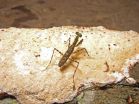(Press-News.org) URBANA, Ill. – Even after the agricultural reforms of 2002-03, for wheat, rice, and pearl millet farmers in India, grain markets are still pretty sticky. Two University of Illinois economists analyzed infrastructure of interstate trade for food-grain crops in three Indian states and found that grain farmers are unable to cash in on India's market reforms and take advantage of a price difference between two or more markets.
"We wanted to see if there was more integration in the markets since the 2002 reforms," said Kathy Baylis. "We were surprised at how little integration we saw. Apparently there are still a lot of regulations in place. A lot of the wholesale markets are not open other than right around harvest. There is a strong incentive to sell at harvest because if you don't you'd have to travel to Delhi or another major city. The ADM Institute for the Prevention of Postharvest Loss that provided the funding for this research is interested in storage, and what we found in India is that there was a huge disincentive to invest in on-farm storage because even if farmers could store their grain for six months or so, they wouldn't be able to sell it then."
Baylis explained that, prior to the reforms of the early 2000s it was difficult in India to transport grain across state lines. The reforms made that easier and also expanded the number of people who could purchase and trade grain. Farmers used to have to go through a long, arduous process to become certified. The reforms eliminated some of those issues, but other problems still plague the system.
"Some people may think of this as only an engineering problem," Baylis said, "where we just need to develop a really good place for them to store the grain. But if there isn't an incentive to store grain to sell later and get a better price, the extra storage won't help farm income."
According to Baylis and her colleague Mindy Mallory, although India still needs some serious policy reform, small innovations could be facilitated to encourage more independent traders to get into the market.
"Anecdotally we heard that in places where there were more active traders, farmers were able to benefit from this market arbitrage potential," Baylis said. "They weren't stuck looking at their own local market. If they worked with a trader, they could keep an eye on what's happening in the city and sell their grain two or three months after harvest."
Baylis said that fruit and vegetable crops, which are highly perishable, tend to have less regulation than the grains and oilseeds.
Because they don't go through the government markets, traders are making investments to get the food from the farmer to the city.
"You have these parallel systems going on," Baylis said. "One is regulated, very structured and not very efficient. One is unregulated and in some cases works well; in other cases, it is also a mess. For vegetable crops, if farmers don't have those linkages, they really can't sell perishable products. There's a massive lack of cold storage in India, for example."
As an economist, Baylis said that she studies how policy can create headaches for farmers and on the consumer end of the supply chain.
"Global food security is often seen as a production issue, but often it's not just lack of water or access to the right seeds," she said. "There has been evidence that major famines, weren't due to a lack of food production, they occurred because you had all of these other institutional crises or economic crises.
"Some people on the outside look at the postharvest loss in India and say we need to develop a better mouse trap – to develop better storage. Our point is that although that's a good thing, if you don't have the right policy and economic incentives, the best mouse trap still won't help."
INFORMATION:
"Food Corporation of India and the Public Distribution System: Impacts on Market Integration in Wheat, Rice, and Pearl Millet," co-authored by Mindy Mallory, was published in an issue of the Journal of Agribusiness.
Incentives needed to improve grain markets in India
2014-03-18
ELSE PRESS RELEASES FROM THIS DATE:
MU study uses video-game device with goal of preventing patient falls
2014-03-18
Technology used in video games is making its way to hospital rooms, where researchers at the University of Missouri hope to learn new ways to prevent falls among hospital patients.
Between 700,000 and 1 million people each year fall in U.S. hospitals, according to the Agency for Healthcare Research and Quality. Hospitals nationwide are looking for ways to reduce that number.
"Since 2008, we've investigated ways to detect and prevent falls by older adults living in independent senior apartments," said Marilyn Rantz, PhD, RN, a leader of the MU research team and a professor ...
Reintroduction experiments give new hope for a plant on the brink of extinction
2014-03-18
A critically endangered plant known as marsh sandwort (Arenaria paludicola) is inching back from the brink of extinction thanks to the efforts of a UC Santa Cruz plant ecologist and her team of undergraduate students.
Ingrid Parker, the Langenheim professor of plant ecology and evolution at UC Santa Cruz, got involved in the marsh sandwort recovery effort at the request of the U.S. Fish and Wildlife Service (USFWS). Although it used to occur all along the west coast, from San Diego to Washington state, this wetland plant with delicate white flowers had dwindled to one ...
New therapeutic target discovered for Alzheimer's disease
2014-03-18
A team of scientists from the University of California, San Diego School of Medicine, the Medical University of South Carolina and San Diego-based American Life Science Pharmaceuticals, Inc., report that cathepsin B gene knockout or its reduction by an enzyme inhibitor blocks creation of key neurotoxic pGlu-Aβ peptides linked to Alzheimer's disease (AD). Moreover, the candidate inhibitor drug has been shown to be safe in humans.
The findings, based on AD mouse models and published online in the Journal of Alzheimer's Disease, support continued development of cysteine ...
Chronic sleep disturbance could trigger onset of Alzheimer's
2014-03-18
People who experience chronic sleep disturbance—either through their work, insomnia or other reasons—could face an earlier onset of dementia and Alzheimer's, according to a new pre-clinical study by researchers at Temple University.
"The big biological question that we tried to address in this study is whether sleep disturbance is a risk factor to develop Alzheimer's or is it something that manifests with the disease," said Domenico Praticò, professor of pharmacology and microbiology/immunology in Temple's School of Medicine, who led the study.
Initially, the researchers ...
Parents matter more than they think in how their children eat
2014-03-18
AURORA, Colo. (March 17, 2014) - Helping children learn to eat well can be a challenge. Some children happily eat whatever is put in front of them while others seem to eat like birds and exist more on air than food. A new study by a researcher at the University of Colorado School of Medicine shows that parents influence how much children eat more than they may think.
In this collaborative study between the CU School of Medicine, Baylor College of Medicine and University of Alabama Birmingham, researchers observed normal, everyday mealtimes in the homes of 145 parents ...
An end to animal testing for drug discovery?
2014-03-18
DALLAS, March 18, 2014 — As some countries and companies roll out new rules to limit animal testing in pharmaceutical products designed for people, scientists are stepping in with a new way to test therapeutic drug candidates and determine drug safety and drug interactions — without using animals. The development of "chemosynthetic livers," which could dramatically alter how drugs are made, was presented at the 247th National Meeting & Exposition of the American Chemical Society (ACS), the world's largest scientific society.
The meeting features more than 10,000 presentations ...
Form of epilepsy in sea lions similar to that in humans, Stanford researchers find
2014-03-18
STANFORD, Calif. — California sea lions exposed to a toxin in algae develop a form of epilepsy that is similar to one in humans, according to a new study led by Stanford University School of Medicine researchers.
Every year, hundreds of sea lions wash up along the California coast, suffering seizures caused by exposure to domoic acid, a neurotoxin that can produce memory loss, tremors, convulsions and death. Domoic acid is produced by algae blooms that have been proliferating along the coast in recent years, accumulating in anchovies and other small fish that the sea ...
New view of supernova death throes
2014-03-18
WASHINGTON D.C., March 18, 2014 -- A powerful, new three-dimensional model provides fresh insight into the turbulent death throes of supernovas, whose final explosions outshine entire galaxies and populate the universe with elements that make life on Earth possible.
The model is the first to represent the start of a supernova collapse in three dimensions, said its developer, W. David Arnett, Regents Professor of Astrophysics at the University of Arizona, who developed the model with Casey Meakin and Nathan Smith at Arizona and Maxime Viallet of the Max-Planck Institut ...
Nineteen new speedy praying mantis species discovered that hide and play dead to avoid capture
2014-03-18
A scientist has discovered 19 new species of praying mantis from Central and South America. The new species of bark mantises were discovered in tropical forests and also found among existing museum collections. Dr. Gavin Svenson, curator of invertebrate zoology at The Cleveland Museum of Natural History, described the new species and published a revision of the genus Liturgusa in the open access journal ZooKeys.
Svenson collected the insects from eight countries in Central and South America, as well as gathered hundreds of specimens from 25 international museums in ...
Child ADHD stimulant medication use leads to BMI rebound in late adolescence
2014-03-18
A new study from researchers at Johns Hopkins Bloomberg School of Public Health found that children treated with stimulants for attention deficit hyperactivity disorder (ADHD) experienced slower body mass index (BMI) growth than their undiagnosed or untreated peers, followed by a rapid rebound of BMI that exceeded that of children with no history of ADHD or stimulant use and that could continue to obesity.
The study, thought to be the most comprehensive analysis of ADHD and stimulant use in children to date, found that the earlier the medication began, and the longer ...


